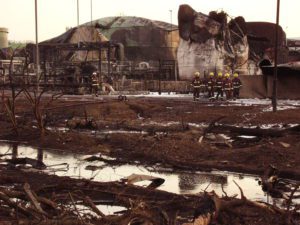The Incident
On 11th December 2005, near Hemel Hempstead in Hertfordshire, a major fire broke
out at an oil storage facility. The organisation had a capacity of 60 million imperial
gallons (273 million litres) making it the fifth largest in the UK. This was the biggest
explosion in the UK since the Flixborough disaster in 1974.
A large explosion was heard at 6.01 am near tank 912, followed by more explosions
which affected 20 large storage tanks. It was found that the cause of the explosion
was a fuel-air explosion in a vapour cloud of evaporated leaking fuel.
The explosion was reportedly heard 125 miles (200 km) away, as far afield as
Belgium, France and the Netherlands. The British Geological Survey measured it at
2.4 on the Richter scale.
Witnesses reported seeing flames of a hundred feet high, and the smoke cloud was
visible from space, and from 70 miles (110 km) away in Lincolnshire. Many buildings
suffered broken windows, blown in or warped front doors, and an entire wall of a
warehouse more than half a mile away was destroyed as a result of the explosion.
A nearby office block had almost every window broken, and there were reports that
cars in streets nearby caught fire. At least one house had its roof blown off. Many
businesses in the Maylands industrial area were affected, the worst being Northgate
Information Solutions and Fujifilm. Some buildings were damaged so badly they
were unusable. The Fujifilm building was demolished and had been completely
remove by June 2006.
Initially over 150 firefighters attended the incident, beginning to tackle the fire at 8.20
am. In total, 75% of Hertfordshire firefighters and support from 16 other brigades
tackled the fire. After initial containment, they had planned to use foam, but were
unable to do so because of the risk of pollution to local rivers and water sources.
Two further tank fires had been extinguished by 4.30 pm on Monday 12 th December,
but another tank that had ruptured was threatening an explosion in a near-by tank.
Another fire broke out in the early morning of December 14 th , and as it was well
contained, it was allowed to burn itself out as it was thought there was a danger of
explosion, or risk of petroleum vapour igniting if they intervened.
The Causes
In February 2011 The Major Incident Investigation Board (MIIB) released their final
report which had been written in 2008. They found that Tank 912 was being filled
with petrol. The levels were monitored manually using a level gauge in the tank, and
an independent high level switch would shut off inflow if the level got above a set
point.
On tank 912 the independent shut off switch was inoperable and the manual gauge
was stuck so they did not know how much petrol was in the tank. Eventually the tank
filled to overflowing through the vents at the top. A vapour cloud formed near ground
level, and this ignited and exploded. The fires from the explosion burned for five
days.
It was reported that following a tank service in August 2005 maintenance contractors
and site had known that the level gauge stuck at random times but had been
unconcerned.


